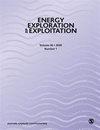Reservoir characterization of the shallow to deep Longmaxi formation in the Weiyuan Block, southwestern Sichuan Basin
IF 1.6
4区 工程技术
Q4 ENERGY & FUELS
引用次数: 0
Abstract
Marine shale gas exploration targets are reaching into shallow to deep or ultradeep burial depths. Rock microstructure and reservoir quality emerge as the main risk considerations for a profitable reservoir at these large depths. Shallow to deep marine shales occur in the Silurian Longmaxi Formation of the Weiyuan Block, which is located on the southwestern margin of the Sichuan Basin. However, few details of the characteristics of the Longmaxi shales in this Block have been reported. In this study, five wells approximately 3500 m deep were drilled. Field emission scanning electron microscopy, low-pressure gas adsorption and core plug porosity-permeability measurements are conducted on 6 shallow (2651–2940 m) and 11 deep (3539–3575 m) Longmaxi samples to obtain the organic geochemical characteristics, mineral constitutions, pore structures and petrophysical properties, and they are the major controls on reservoir quality. The results show similar mineralogical and organic geochemical characteristics in all samples from the various depths. Both shallow and deep shales are mainly composed of quartz, carbonate and clays and have a total organic carbon (TOC) content more than 2 wt.% and a mean S1 + S2 value more than 52 mg/g. Source rock quality criteria using the TOC and S1 + S2 suggest most shale samples fall excellent source rocks. The samples are mostly siliceous rocks that contain organic pores, intraparticle dissolution pores, interparticle quartz pores and interparticle clay pores and they play a positive role in improving reservoir quality. Pore surface area and pore volume increase with increasing TOC, indicating that the porous organic fraction is a major control on pore structure and porosity. We suggested that siliceous deep Longmaxi formation in Weiyuan Block belongs to a high-quality shale with an average TOC value of 3.9 wt.% and well-developed pore networks, which should be the important target for deep shale gas exploration.四川盆地西南部威远地块龙马溪组浅部至深部储层特征
海相页岩气勘探目标向浅层至深层或超深层延伸。在这些大深度,岩石微观结构和储层质量成为考虑盈利油藏的主要风险因素。四川盆地西南缘威远地块志留系龙马溪组发育浅-深海相页岩。然而,有关龙马溪组页岩特征的详细报道较少。在这项研究中,共钻了5口约3500米深的井。对龙马溪浅部(2651 ~ 2940 m) 6个样品和深部(3539 ~ 3575 m) 11个样品进行了场发射扫描电镜、低压气体吸附和岩心塞孔渗透率测量,获得了有机地球化学特征、矿物组成、孔隙结构和岩石物理性质,这些是控制储层质量的主要因素。结果表明,不同深度样品的矿物学和有机地球化学特征相似。浅部和深层页岩均以石英、碳酸盐和粘土为主,总有机碳(TOC)含量均大于2 wt。%,平均S1 + S2值大于52 mg/g。采用TOC和S1 + S2的烃源岩质量标准表明,大多数页岩样品属于优质烃源岩。样品多为硅质岩,含有机质孔、颗粒内溶蚀孔、颗粒间石英孔和颗粒间粘土孔,对提高储层质量具有积极作用。孔隙表面积和孔隙体积随有机质含量的增加而增大,表明孔隙有机质组分是孔隙结构和孔隙度的主要控制因素。认为威远地块深部龙马溪组硅质页岩为优质页岩,平均TOC值为3.9 wt。孔隙网络发育,应成为深部页岩气勘探的重要目标。
本文章由计算机程序翻译,如有差异,请以英文原文为准。
求助全文
约1分钟内获得全文
求助全文
来源期刊

Energy Exploration & Exploitation
工程技术-能源与燃料
CiteScore
5.40
自引率
3.70%
发文量
78
审稿时长
3.9 months
期刊介绍:
Energy Exploration & Exploitation is a peer-reviewed, open access journal that provides up-to-date, informative reviews and original articles on important issues in the exploration, exploitation, use and economics of the world’s energy resources.
 求助内容:
求助内容: 应助结果提醒方式:
应助结果提醒方式:


